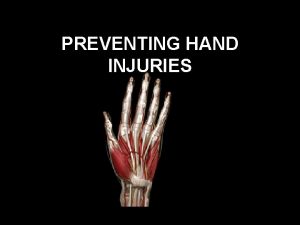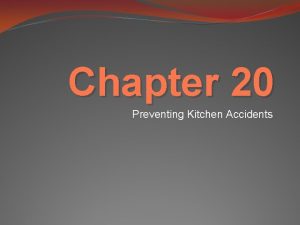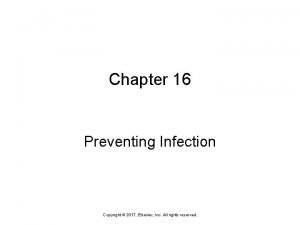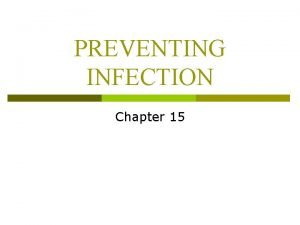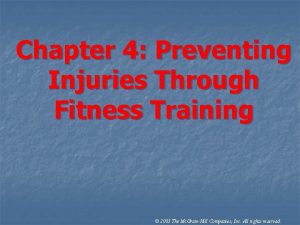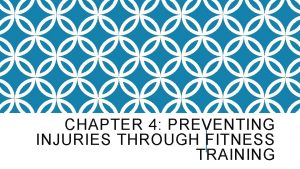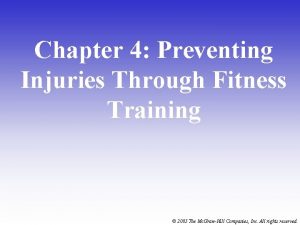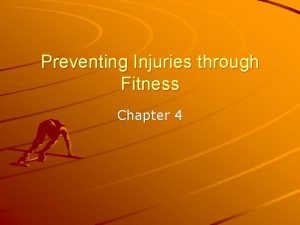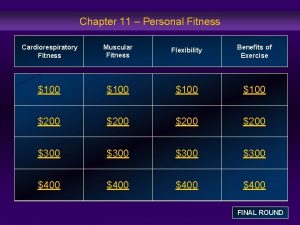Preventing Injuries Through Fitness Training Chapter 4 Pages











- Slides: 11

Preventing Injuries Through Fitness Training Chapter 4 Pages 61 -121

Conditioning Seasons and Periodization n n Periodization – allows athletes to train year-round with less risk of injury and staleness. Macrocycle n n n Periodization organizes a training program into cycles A complete training period is 1 yr or 4 yrs-----This is a macrocycle Divide into-----preseason, in-season, off season Intensity, volume, specificity of training are altered As competition approaches, training sessions change gradually from high volume/low intensity, non specific to low volume/high intensity sport specific

Periodization n Mesocycle n n With macrocycle, several mesocycles----each several weeks or months Mesocycles are divided into: 1. Preparatory-during off season 3 phases A. hypertrophy/endurance phase B. strength phase C. power phase- pre season- high intensity/ low volume 2. Competition Phase-may last a week or less---high intensity training/low volume---Develop microcycles from 1 -7 days---intense early in the week and light the day before the competition 3. Transition Phase- After last competition and off season, encouraged to do recreation sports

Said Principle n n n SAID- Specific Adaptations of Imposed Demands SAID Principle States- when the body is subject to stress and overloads of carrying intensities, it will gradually adapt overtime to overcome whatever demands are placed on it. The stress must not be great enough to produce damage or injury before the body has a chance to adjust to the demands

10 Cardinal Principles of Conditioning & SAID Principle 1. 2. 3. 4. 5. 6. 7. 8. 9. 10. Warm-up/Cool-down Motivation Overload Consistency Progression Intensity Specificity Individuality Stress Safety

Flexibility n n Flexibility – the range of motion possible about a joint or series of joints. Anatomical structures that can limit flexibility: bone, fat, skin, scar tissue, muscles, tendons, connective tissue. AROM vs. PROM Stretching Techniques: n n Assessment of Flexibility: n n Ballistic Static PNF Trunk Hip Flexion Test Trunk Extension Test Shoulder Extension Test The Relationship between Strength and Flexibility

Agonist vs antagonist muscles n n Agonist-the muscle that contracts to produce a movement—example quad Antagonist- the muscle being stretched in response to the contraction of the agonist muscle---example ham

Importance of Muscular Strength, Endurance, & Power n n n Muscular Strength – the maximum force that can be applied by a muscle during a single maximum contraction. Muscular Endurance – the ability to perform repetitive muscular contractions against some resistance. As muscle strength increases there seems to be an increase in muscle endurance. Power – the ability to generate force rapidly. Types of Skeletal Muscle Contraction: n n n Isometric Concentric Eccentric

Factors That Determine Muscle Strength n n n n Size of the muscle n Muscle strength is proportional to the cross-sectional diameter of the muscle fiber. n Hypertrophy vs. Atrophy Number of muscle fibers n Strength is function of number of muscle fibers in muscle. Neuromuscular efficiency n Motor unit Biomechanical factors Fast-twitch vs. Slow-twitch n Fast-twitch: powerful/explosive movements n Slow-twitch: endurance activities Level of physical activity Overtraining n Staleness

Cardiorespiratory Fitness and Athletes n n n Cardiorespiratory Endurance – ability to perform activities for extended periods. Cardiorespiratory system supplies oxygen to various tissues of the body. Aerobic vs. Anaerobic Exercise Cardiorespiratory system is dependant on 4 things: heart, blood vessels, blood, and lungs. How does exercise affect the function of the heart?

Improving Cardiorespiratory Endurance n n n Continuous Training – uses exercises performed at the same level of intensity for long periods. n Type of activity n Frequency of activity n Intensity of activity n Maximum HR = 220 – age. n Duration of activity Interval Training – alternating periods of work with active recovery. Fartlek Training – training technique that is a type of cross -country running. “Speed Play. ” Incorporates surges into the workout.
 Chapter 4 preventing injuries through fitness
Chapter 4 preventing injuries through fitness Chapter 14:3 observing fire safety
Chapter 14:3 observing fire safety Chapter 13:2 preventing accidents and injuries
Chapter 13:2 preventing accidents and injuries Preventing hand injuries
Preventing hand injuries Chapter 12 lesson 1 benefits of physical activity
Chapter 12 lesson 1 benefits of physical activity Printed pages vs web pages
Printed pages vs web pages Chapter 24 lesson 2 preventing and treating stds
Chapter 24 lesson 2 preventing and treating stds Chapter 9 lesson 2 resolving conflicts
Chapter 9 lesson 2 resolving conflicts Chapter 20 preventing kitchen accidents
Chapter 20 preventing kitchen accidents Chapter 16 preventing infection
Chapter 16 preventing infection Chapter 9 resolving conflicts and preventing violence
Chapter 9 resolving conflicts and preventing violence Chapter 15 preventing infection
Chapter 15 preventing infection



